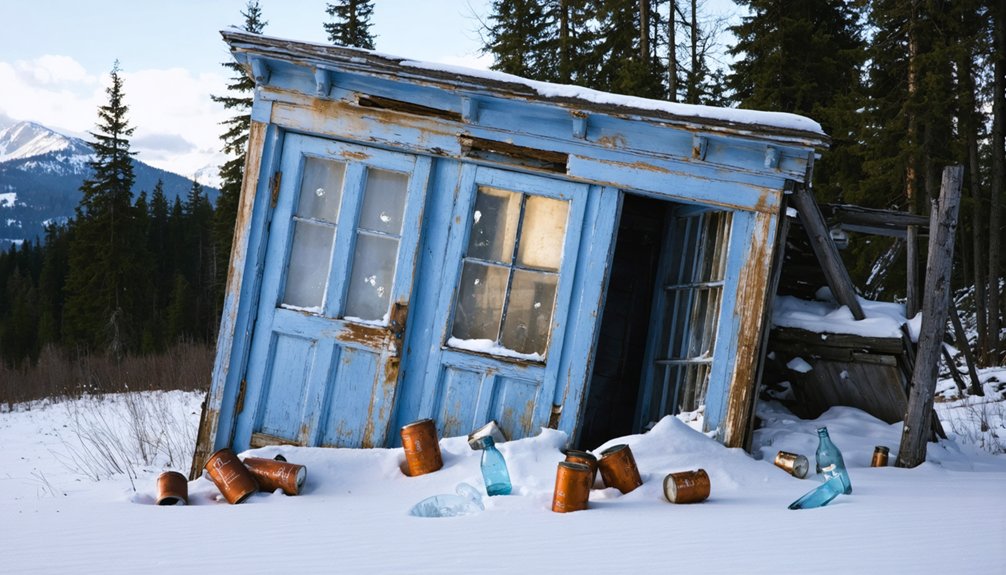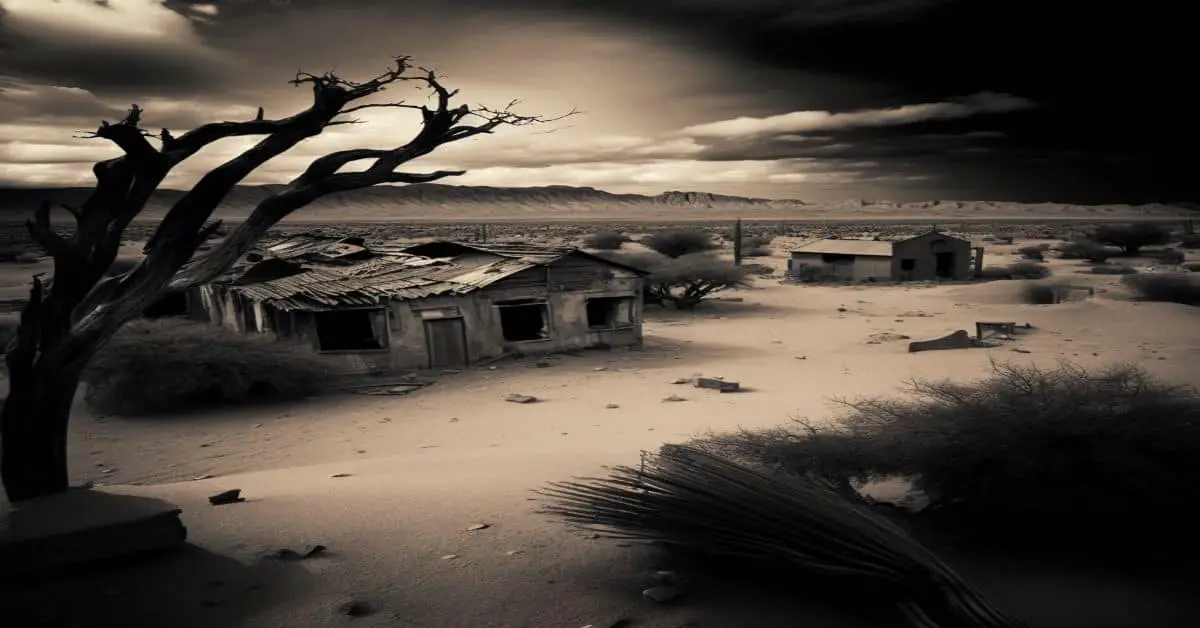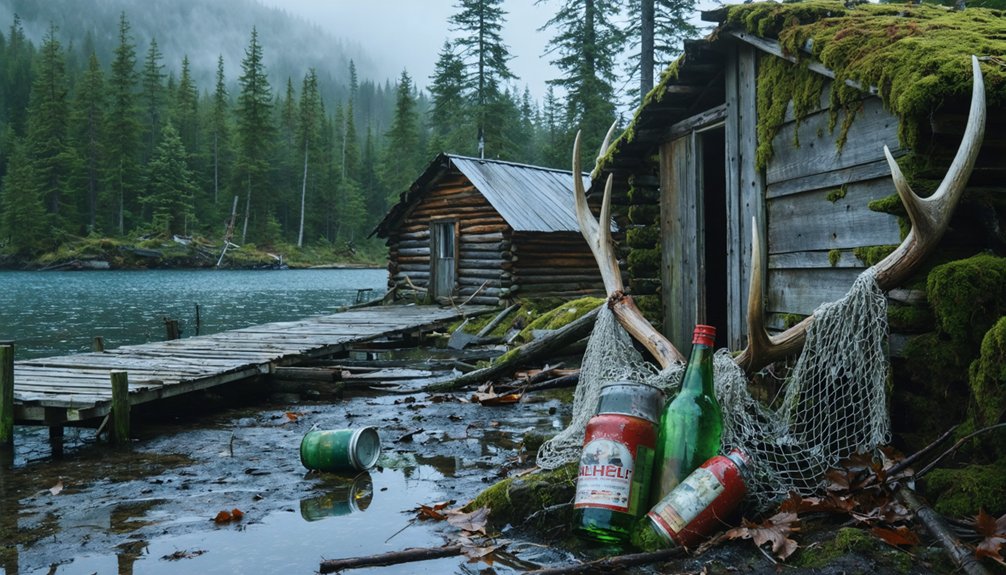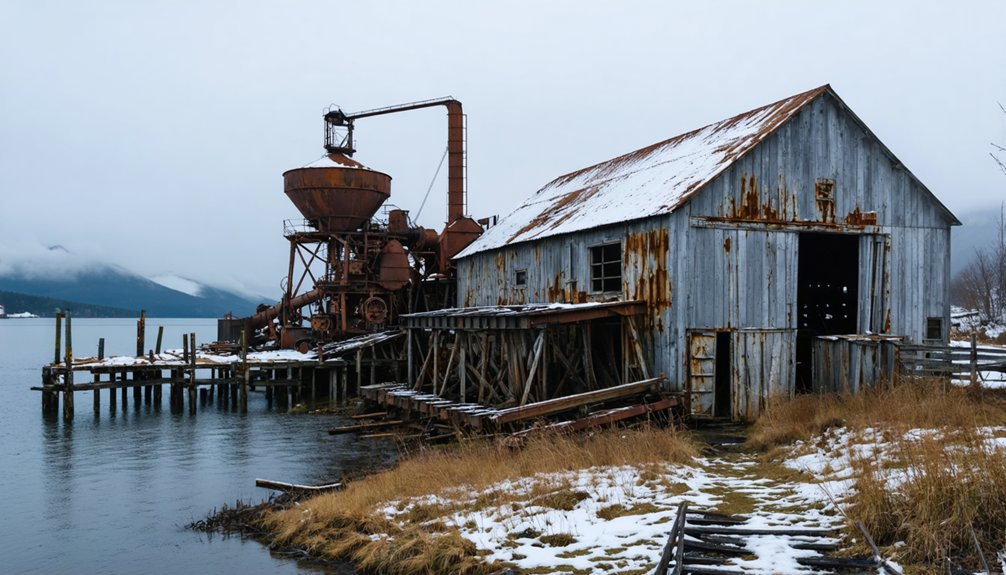You’ll find Olnes, Alaska’s remnants along the old Tanana Valley Railroad, where Norwegian immigrant Nels Olnes established this crucial transportation hub in 1907. The town supported railroad workers and miners with hotels, saloons, and the region’s essential locomotive water source, growing to 300 residents at its peak. By 1930, operations ceased and the population dwindled, leaving behind historic structures that tell a compelling story of Alaska’s gold rush era development.
Key Takeaways
- Olnes was a thriving Alaskan railroad town from 1907 to 1930, serving as a crucial water stop and supply hub for mining operations.
- The town supported up to 300 residents with amenities including hotels, saloons, a post office, and numerous residential cabins.
- As a transportation center, Olnes connected the Tanana Valley Railroad to remote mining camps via horse-drawn wagon routes.
- The town’s decline began after 1930 when railroad operations ceased, leading to population exodus and business closures.
- Today, Olnes stands as a preserved ghost town with remaining structures, including a distinctive outhouse along the old railroad route.
The Norwegian Pioneer Behind the Name
Pioneer spirit drew Norwegian immigrant Nels Olnes to Alaska’s rugged frontier in the early 1900s, where his legacy would shape the region’s development.
As part of a wave of Norwegian settlers seeking opportunity in America’s last frontier, Olnes brought valuable skills in prospecting and homesteading to the Tanana Valley. After learning baking at the Kaiser Wilhelm Institute, he developed crucial expertise that would serve him well in his Alaskan adventures. Like many prospectors who came before him during the Nome Gold Rush, he sought his fortune in Alaska’s mineral-rich territories. You’ll find his influence woven into Alaska’s mining history, where his pioneering contributions helped establish essential infrastructure and economic foundations in the interior.
Like many of his Norwegian heritage, Olnes embodied the determined character of immigrant prospectors who ventured north.
His impact was so significant that settlers named a strategic railroad stop after him, marking his place in Alaska’s story of exploration and development.
Today, the ghost town of Olnes stands as a monument to these hardy pioneers.
Railroad Glory Days: 1907-1930
During Olnes’s peak years from 1907 to 1930, you’d find a bustling railroad stop with essential infrastructure including a depot, machine shop, and the important water tank that served steam locomotives tackling the challenging hills between Chatanika and Gilmore stations.
You could witness a thriving community of 300 residents supported by a diverse collection of businesses, from the general store and hotel to saloons and a post office.
The town’s strategic position as the sole water source for locomotives in the area made it an indispensable hub along the Tanana Valley Railroad, directly supporting the region’s critical mining operations until the narrow gauge line’s decommissioning in 1930. Like many railroad towns of the era, Olnes struggled with profitability, reflecting the widespread challenge that led to a mere 5,400 combined population in Seward, Anchorage, and Fairbanks by 1930. This vital rail line would later become part of the 470-mile mainline stretching from Seward to Fairbanks.
Peak Transportation Hub Operations
The bustling hub of Olnes emerged as an essential stop along the Tanana Valley Railroad‘s 45-mile narrow-gauge line between Fairbanks and Chatanika, hosting important facilities that included a depot, warehouse, and machine shop.
At its peak, you’d find a thriving community of 300 residents supporting the complex transportation logistics of Alaska’s interior.
You couldn’t miss the strategic importance of Olnes’s location, positioned on the north side of steep hills where locomotives needed full steam to climb.
Rail operations depended on the water tank near the creek, making Olnes an irreplaceable stop between Chatanika and Gilmore stations.
The town’s amenities catered to both travelers and workers, featuring a general store, hotel, saloons, boarding house, post office, and livery stable – all essential to keeping the railroad’s lifeblood flowing.
Horse-drawn wagons transported goods between Olnes and the remote mining camps, creating vital supply connections for the region’s mineral extraction operations.
Local Business Growth Era
As railroad operations flourished between 1907 and 1930, Olnes blossomed into a vibrant commercial center serving both railroad workers and travelers along the Tanana Valley Railroad line.
The federal government’s investment in Alaska’s railroad infrastructure helped sustain communities like Olnes during this period.
You’d find remarkable business diversification throughout the town, with establishments including a general store, hotel, multiple saloons, a boarding house, post office, and livery stable.
The community’s resilience was evident in its ability to support roughly 300 residents during its peak, making it a significant settlement for interior Alaska at the time.
The town’s strategic location and diverse commercial offerings made it an essential hub for the region’s economic activity.
You could see the results of this prosperity in the numerous residential cabins and houses built to accommodate the growing workforce and their families who depended on the railroad and its supporting businesses.
Mining Industry Support Network
While Olnes established itself as a bustling railroad town, its true economic engine lay in supporting the region’s thriving mining industry between 1907 and 1930.
Three trains daily connected mining communities as the railroad advertised regular service between Fairbanks and The Creeks.
You’d find the Tanana Valley Railroad efficiently moving mining equipment, supplies, and precious gold dust between Fairbanks and remote camps near Livengood and Tolovana.
Mining logistics revolved around Olnes as a vital transshipment point, where cargo would transfer from rail to horse-drawn wagons for the final trek to isolated claims.
Despite transportation challenges like periodic flooding and high equipment costs, the railroad made mining operations economically viable.
Workers earned up to $7.50 per day, and the steady flow of passengers and freight through Olnes kept the town’s economy humming until the easy gold played out and the railroad ceased operations in 1930.
Mining’s Impact on Local Development
You’ll find that mining operations around Olnes followed typical patterns of boom-and-bust development, with early placer mining giving way to more mechanized extraction methods that required larger workforces.
The region’s mining complexes drew workers from across Alaska and beyond, establishing temporary settlements that supported hundreds of miners and their families. Like many mining communities across Alaska, Olnes benefited from the expertise of Sourdough society leaders who helped establish the early infrastructure.
As operations expanded through the 1920s and 1930s, you could see the evolution from simple mining camps to more structured communities with essential services and infrastructure, though these would later fade as mineral resources depleted.
Copper Mining Economic Impact
The discovery of copper deposits near Olnes transformed Alaska’s economic landscape during the early 20th century, with the Kennecott Copper Mine emerging as a powerhouse that produced 4.6 million tons of high-grade ore between 1911 and 1938.
The copper valuation reached staggering heights, with 1916’s production alone worth $30 million (about $443 million today). Mining profits fueled massive infrastructure development, as the Alaska Syndicate built essential railroads and shipping routes connecting Olnes to Fairbanks and beyond. These early operations were particularly successful due to ore samples containing up to 70% copper content. The Guggenheim and Morgan-backed operations invested 25 million dollars to develop the mines between 1905 and 1911.
You’ll find the impact wasn’t just in raw numbers – hundreds of workers found steady employment, while secondary industries flourished in transportation, equipment maintenance, and supply services.
This economic surge helped establish stable communities, though they’d later face decline when high-grade ores were depleted in the late 1930s.
Labor Migration Patterns
Mining’s economic prosperity brought significant demographic changes to Olnes, as labor migration patterns shaped the region’s development throughout the early 1900s.
You’ll find that the town’s population ebbed and flowed with mining cycles, experiencing surges during boom periods followed by stark declines when projects contracted. The harsh geography and isolation of Olnes created persistent labor shortages, as workers often stayed only briefly before seeking opportunities elsewhere.
Like many Alaskan mining towns, Olnes struggled with seasonal workforce fluctuations that hampered sustained community growth.
Migration trends show that younger workers increasingly chose to leave for the Lower 48, while the aging population and high living costs made it difficult to attract permanent residents.
These demographic shifts ultimately contributed to the town’s eventual decline and ghost town status.
Life in a Frontier Railroad Town
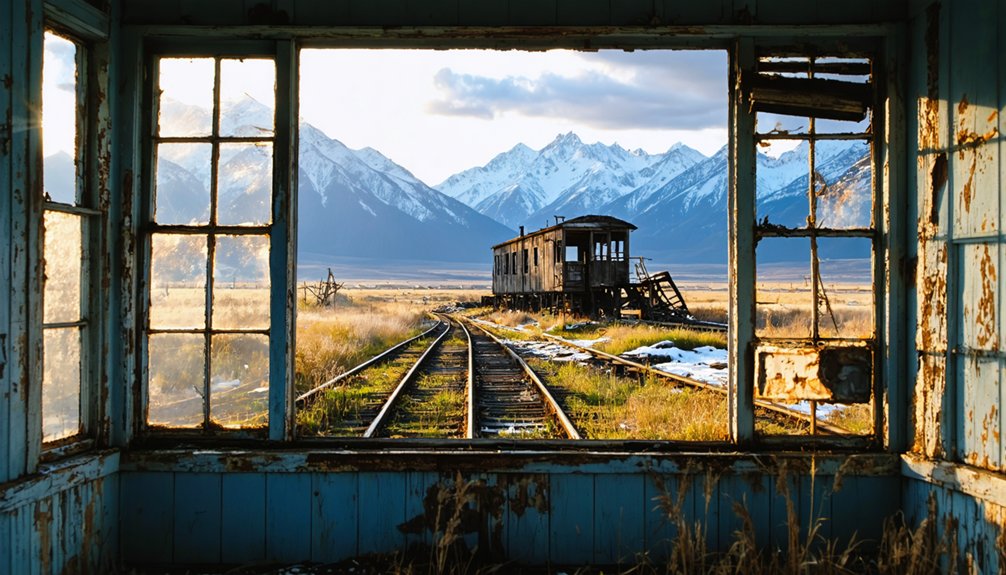
Situated strategically between Fairbanks and the Chatanika mining district, Olnes flourished as a bustling frontier railroad town of 300 residents during the early 1900s.
You’d find railroad workers gathering at the local saloons after their shifts, while the boarding house provided a home for those passing through. The town’s heart beat around its railroad depot, warehouse, and machine shop, where the constant rhythm of arriving and departing trains kept the community alive.
Life centered around the basic amenities you’d need to survive – a general store, post office, hotel, and livery stable.
The town’s position near a creek meant locomotives could fill up with water before tackling the steep grades ahead, making Olnes an essential stop on the frontier railroad network.
The Exodus: When Olnes Went Silent
Unlike many Alaskan ghost towns that vanished overnight, Olnes’s transformation into a silent settlement unfolded gradually after 1930 when the Tanana Valley Railroad ceased operations.
You wouldn’t have witnessed mass evacuations or dramatic departures – instead, the town’s gradual decline reflected a quiet exodus as mining opportunities dwindled and transport links disappeared.
The silent departure left traces you can still find today, most significantly a distinctive outhouse along the old railroad right-of-way, complete with wood-shake roofing, iron filigree, and red brocade wallpaper.
An ornate frontier outhouse, adorned with iron filigree and brocade walls, stands as a peculiar remnant of Olnes’s vanished community.
While other buildings were dismantled, relocated, or left to decay, this solitary structure stands as a symbol of Olnes’s frontier past.
The town’s slow fade into obscurity continued through the 1970s, when the last retail establishment finally closed its doors.
Surviving Structures and Ruins
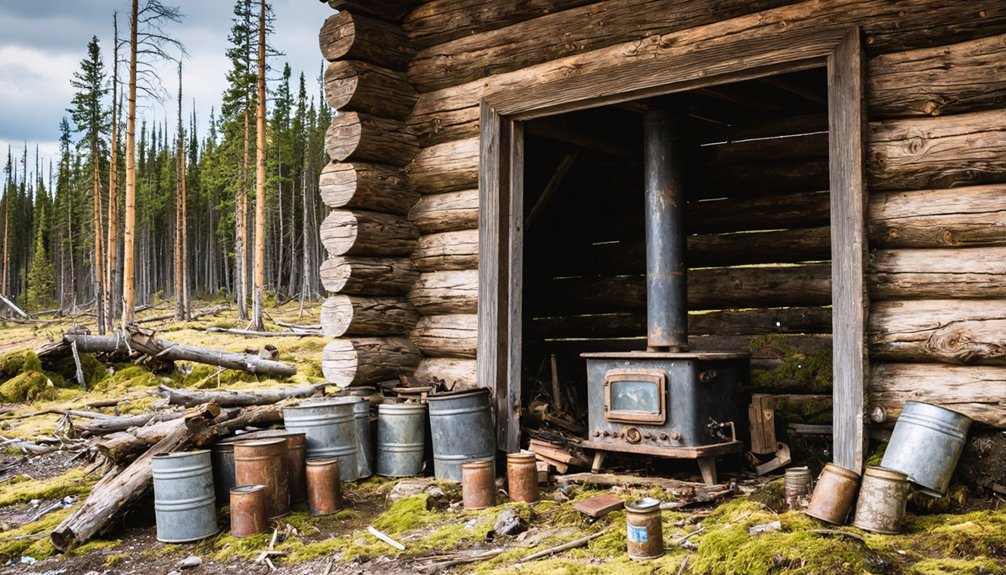
Today’s visitor to Olnes will find sparse physical evidence of its once-bustling frontier past. Nearly all original buildings have vanished, leaving only scattered foundation remnants and patches of barren earth where sheetrock and plaster prevent vegetation growth.
The most intriguing survivor is a small outhouse along the old railroad right-of-way. Its wood-shake roof, iron filigree gables, diamond-shaped window, and remnants of red brocade wallpaper showcase decorative elements unusual for such utilitarian structures.
Until the 1990s, a false-front store near the Elliott Highway stood as another link to the past before fire claimed it.
While lacking architectural significance compared to Alaska’s grander ghost towns, Olnes’s ruins tell a quieter story of gradual decline rather than sudden abandonment or industrial destruction.
Natural Reclamation of the Settlement
Since its abandonment in the early twentieth century, nature has steadily reclaimed Olnes’s footprint through typical Alaskan succession patterns.
The natural ecology has transformed the once-bustling settlement through relentless cycles of growth and decay. You’ll find evidence of this transformation throughout the former townsite, where pioneer species first colonized the disturbed soil, followed by increasingly complex plant communities.
The wildlife resurgence is visible in three distinct ways:
- Small mammals and birds now inhabit deteriorating structures as natural shelters.
- Dense undergrowth and saplings have invaded former roads and building foundations.
- Large wildlife like moose and bears regularly traverse the area, further breaking down remaining structures.
Alaska’s harsh climate accelerates this reclamation through freeze-thaw cycles, heavy snowfall, and permafrost activity, steadily erasing human presence from the landscape.
Historical Preservation Efforts
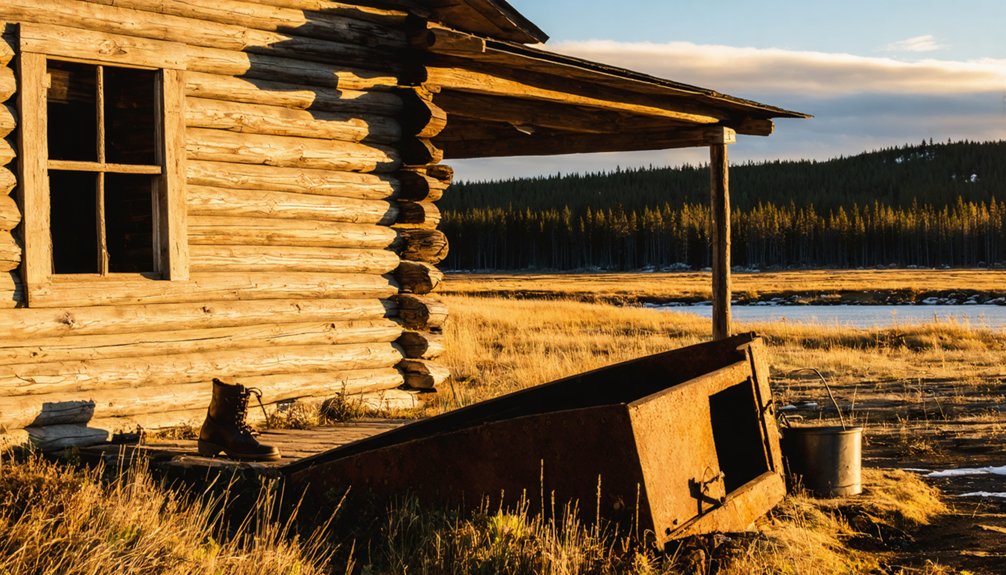
Despite Olnes’s deteriorating condition, significant preservation efforts have emerged through Alaska’s Historic Preservation Plan to document and protect this important ghost town.
You’ll find historic preservation teams working to stabilize deteriorating structures through roof repairs and foundation reinforcement while detailed surveys and mapping document the site’s remaining features.
The preservation work isn’t happening in isolation – it’s part of a broader regional strategy that brings together government agencies, local communities, and indigenous groups.
Through coordinated planning, you can see how community involvement has grown, with volunteers participating in site maintenance and educational outreach programs.
Local volunteers breathe new life into historic sites through dedicated maintenance work and community education initiatives.
While funding challenges and harsh weather conditions create ongoing obstacles, preservation advocates continue pushing forward with awareness campaigns and collaborative partnerships to guarantee this piece of Alaska’s history won’t be lost to time.
Legacy in Alaska’s Mining Era
While many Alaskan gold rush towns experienced sudden booms and busts, Olnes carved out a distinctive legacy as an essential trans-shipment hub that helped sustain the broader Fairbanks Mining District.
You’ll find Olnes’ history deeply woven into the region’s mining economy, which produced over 12 million ounces of gold by 1910.
When you look at Olnes’ unique contributions, you’ll discover:
- A sophisticated rail-to-wagon transport system that connected remote mining camps to Fairbanks
- A gradual decline that preserved structures instead of the typical sudden abandonment
- A lasting impact on settlement patterns that shaped Alaska’s interior development
Unlike its more famous counterparts, Olnes didn’t vanish overnight but slowly faded as placer mining declined, leaving behind a testimony to Alaska’s resourceful mining pioneers.
Frequently Asked Questions
Can Visitors Legally Explore and Photograph the Remains of Olnes Today?
You can explore publicly accessible areas and take photos, but you’ll need to check local land records for legal permissions and follow basic photography guidelines regarding private property boundaries.
Are There Any Documented Paranormal Activities or Ghost Stories From Olnes?
You won’t find documented ghost sightings or haunted locations from Olnes in historical records. Unlike other Alaskan ghost towns with rich paranormal folklore, this transport hub’s gradual decline left few supernatural tales behind.
What Wildlife Species Now Inhabit the Abandoned Town Site?
Nature’s squatters have reclaimed their turf – you’ll spot moose wandering through crumbling walls, black bears foraging nearby, and ravens nesting in old roofs. Wildlife sightings show natural habitat restoration’s success.
How Many People Lived in Olnes During Its Peak Population?
You’ll find that Olnes’ history shows a peak population of roughly 300 people during the bustling railroad days, when the town’s economy thrived with its depot, stores, saloons, and boarding houses.
Were There Any Notable Crimes or Scandals in Olnes’s History?
While you might expect wild tales from an Alaskan mining town, there aren’t any documented notable crimes or town scandals in Olnes’s history. The town’s decline was purely economic, not scandalous.
References
- https://www.youtube.com/watch?v=Cz0IGc2Uy0E
- https://www.thealaskalife.com/blogs/news/alaska-ghost-towns-youve-probably-never-heard-of
- https://motorcyclemojo.com/2015/09/alaska-ghost-towns/
- https://www.geotab.com/ghost-towns/
- https://www.sketchesofalaska.com/2012/05/old-outhouse-at-olnes-has-unique.html
- https://en.wikipedia.org/wiki/List_of_ghost_towns_in_Alaska
- https://www.juneauempire.com/life/ghost-towns-scattered-across-the-alaska-map/
- https://en.wikipedia.org/wiki/Nome_Gold_Rush
- http://www.sitnews.us/JuneAllen/ChrisLeding/040705_pioneer_alaskan.html
- https://slettebo.no/norway-in-america/alaska.htm
